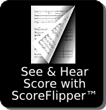12 Jazz Duets for 2 Flutes
| Composer | Gale, Jack |
|---|---|
| Duration | 12 |
| Ensemble | Flute Duet |
| Genre | Jazz |
| Grade | 4 |
| Model Number | EC204 |
| Category | 2 Flutes |
A Word From Jack Gale…
The duets in this collection were written to be played by my students and me for fun and to improve their jazz phrasing and concepts. Originally written as complete musical works for two players, these duets can also be accompanied in several exciting ways. A drummer playing simple time will complement the duet parts and add rhythmic impact. The chord symbols can be used by a bass player and/or a pianist to provide a small jazz group effect. The tempo markings are only included as a general indication; wide variations are possible. Duet No. 4, for example – the Blues Canon – can be played at virtually any tempo the players find comfortable. The duets range in difficulty from fairly easy to challenging. I hope you will enjoy these duets and find them educational and challenging. Some of them will be quite playable, virtually at sight; other may take many hours of practice to perfect.
NOTE: This product includes the sheet music PLUS (if ordered as a PDF) sound files you can play on a Mac or PC. The sound files includes a rhythm section that you can play along with and another version of the tune with the duet parts being played by prominent New York jazz flutist Bernie Berger along with rhythm section. Note the occasional grace notes Bernie adds from time to time. Feel free to alter the music in any way that seems to work when playing these duets yourself. THE HARD COPY VERSION DOES NOT INCLUDE A CD. MP3 files can be emailed upon request.
Duet No. 1 is based on the Bb Blues. As in all of the medium and up-tempo duets, the figures should be played with a 12/8 swing feel. At bar 37 the lead passes back and forth every bar for three measures.
Duet No. 2 is a popular swing standard which uses both concerted figures and simple contrapuntal lines. Note the optional lower notes in bars 4 and 12.
Duet No. 3 is a standard ballad. It should be played with straight eighths. It is a lyrical example of ballad improvisation, and an endurance-building exercise. It will require careful pacing to get through with control and grace.
Duet No. 4 is actually a Blues Canon. Note that the second part is identical with the first except that it begins a bar later. Try to retain the individuality of each line while fitting them together.
Duet No. 5 contains some complex lines which should be played without losing the 12/8 swing feel throughout. It is based on the basic “rhythm” harmonic progression.
Duet No. 6 uses another basic harmonic pattern. the 16 bar “Scat” form which dates back to the 1920’s. It should be played with a strong “blues”flavor and a pronounced l2/8 feel.
Duet No. 7 may require a certain amount of practice to get all of the notes in the right places. It is based on a popular jazz standard from the bop era. Be careful with the pitch so that the many chord changes within the tune are clearly heard.
Duet No. 8 is based on an extended set of “turnaround” chord changes. In effect. it continually modulates along variations on the cycle of fifths. It may also provide an endurance challenge. so be sure to pace.
Duet No. 9 is based on an old minor harmonic pattern with an added modal touch at the beginning. Try to retain the individual lines but catch the occasional concerted figures (bars 15 and 27).
Duet No. 10 is a more modern pattern of very difficult chord changes and shifting tonalities. Try to bring out the bar-by-bar modulations in the bridge (bars l7 through 24).
Duet No. 11 is a classic ballad pattern in c minor. The eighth notes are straight and the articulation should be as smooth as possible. Pacing is essential.
Duet No. 12 is based on a very contemporary pattern of constant modulation. It will be necessary to carefully maintain both the pitch and the rhythmic values to properly realize all of the intricacies of this duet.









